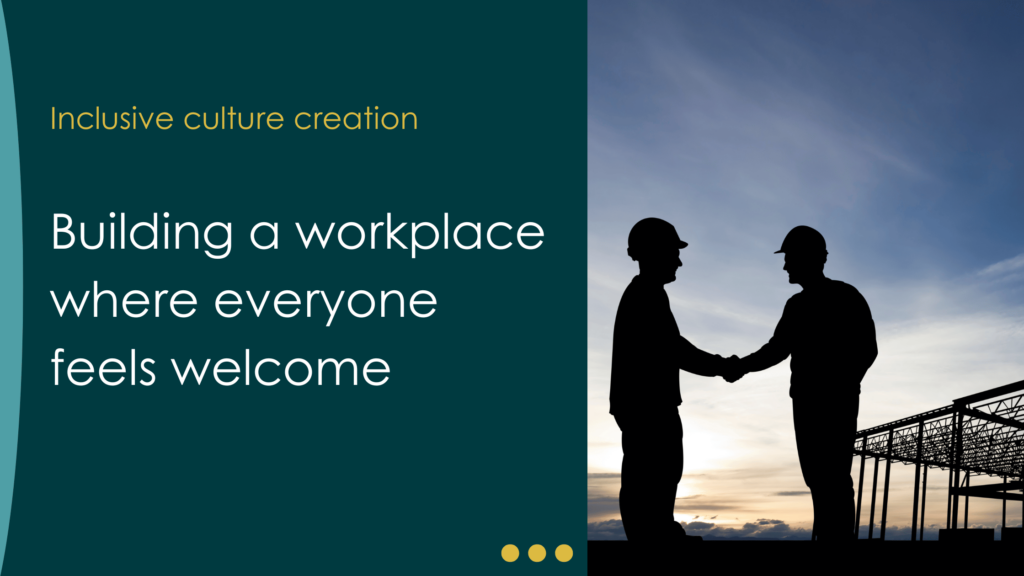Building a workplace where everyone feels welcome
A truly inclusive workplace isn’t just a nice-to-have; it drives engagement, innovation and ultimately, business success. It isn’t just about hiring great people, it’s about creating an environment where everyone feels valued, respected and able to do their best work. But why is it so important – and how can you achieve it?
Why inclusion matters
A diverse workforce alone isn’t enough, people need to feel seen, heard and included. When employees feel like they belong, they’re more engaged, more productive and more likely to stick around. Businesses that prioritise inclusion see higher levels of collaboration, better decision-making and are more profitable. They also need to feel safe, and there are increasingly strict regulations to ensure that all businesses support difference, health and wellbeing across diverse workforces.
In industries like construction, where historically some groups have been underrepresented, creating a welcoming environment is even more crucial. It’s not just about ticking boxes, it’s about ensuring every team member can contribute fully and thrive.
What does an inclusive culture look like?
An inclusive workplace doesn’t happen by accident, it’s built through conscious effort and leadership commitment. Key indicators include:
- Employees feel safe speaking up and sharing ideas
- Hiring and promotion decisions are based on merit, not bias
- Policies and benefits support a wide range of employee needs
- Training and leadership development reflect diverse perspectives
- A strong focus on mental health, wellbeing, and work-life balance
- People feel safe and supported physically, mentally and emotionally
How to build a more inclusive culture
If you want to create a workplace where everyone feels welcome and safe, start with these practical steps:
1. Leadership commitment
Inclusive cultures start at the top. Leaders must actively champion diversity and inclusion, not just in words but in actions. That means:
- Setting clear expectations around inclusive behaviours
- Holding themselves and each other accountable for progress
- Leading by example through their own actions and decisions
2. Invite and model open communication
People need to feel comfortable sharing their thoughts, experiences and concerns without fear of judgement. This can be encouraged through:
- Regular employee feedback and listening sessions
- Anonymous surveys to identify hidden issues
- Open-door policies where leaders are approachable
It’s so important to demonstrate that you’re listening – there is no point putting in anonymous surveys or encouraging people to confide in their managers if no action or follow up communication ever happens. Leaders must demonstrate that they can take challenging feedback maturely and that there are no negative repercussions, otherwise all efforts will be seen as a hollow gesture.
3. Tackle unconscious bias
Bias, even when unintentional, can hold businesses back. Providing training on unconscious bias helps teams recognise and address barriers to inclusion, particularly in recruitment, promotions, and team dynamics.
One company changed how they hired by anonymising CVs and using structured interview processes, leading to a more diverse and high-performing workforce. Even the most open-minded person will have some unconscious biases and it can be a pervasive influence so it’s important to question the bias in everything from the systems and technology you use to the people running your recruitment and management training.
4. Embed inclusion into policies and practices
True inclusivity isn’t about one-off initiatives, it needs to be woven into how your business operates every day. Consider:
- Reviewing policies to ensure they are fair and accessible
- Offering flexible working arrangements
- Providing clear career development pathways for all employees
- Celebrating a wide range of cultural and professional milestones
- Consult your people and ask them for feedback – mistakes and oversights are human and they do happen, but if you are regularly canvassing opinion and getting honest feedback you should get a good idea of how inclusive your processes and practices really are
5. Build a culture of belonging
A sense of belonging is what turns a diverse workplace into an inclusive one. This means:
- Recognising and celebrating differences
- Encouraging mentorship and sponsorship opportunities
- Creating employee resource groups for underrepresented groups
- Educating everyone in your business about underrepresentation, privilege and bias – whether they think they need it or not
One client in the construction sector saw significant improvements in employee retention and engagement by focusing on these areas – proving that inclusion isn’t just the right thing to do, it’s also good for business.
The bottom line
Creating a truly inclusive culture takes commitment, effort and a willingness to listen and adapt. But the rewards, in terms of employee satisfaction, business performance, and reputation, make it well worth it. It’s also worth remembering that the regulations around diversity and inclusions are increasingly strict and enforceable, so it’s important for compliance, as well as for the wellbeing of your people
If you’d like to explore how People Puzzles can help you create an inclusive culture that delivers real results, get in touch.


